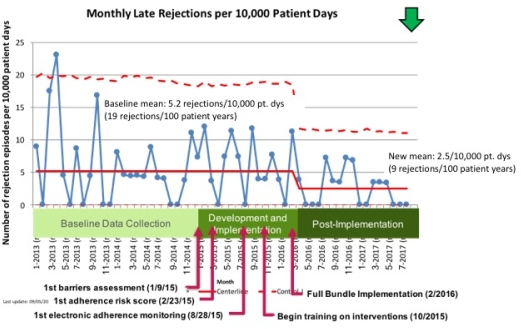Automated Systems to Identify and Address Adherence Barriers Result in Sustained Reduction of Late Allograft Rejection
Cincinnati Children's Hospital Medical Center, Cincinnati, OH.
Meeting: 2018 American Transplant Congress
Abstract number: B225
Keywords: Immunosuppression, Rejection
Session Information
Session Name: Poster Session B: Kidney: Pediatrics
Session Type: Poster Session
Date: Sunday, June 3, 2018
Session Time: 6:00pm-7:00pm
 Presentation Time: 6:00pm-7:00pm
Presentation Time: 6:00pm-7:00pm
Location: Hall 4EF
Background: Patient-identified barriers to taking immunosuppressive medications are associated with rejection and allograft loss, yet interventions targeting adherence barriers are rarely integrated into clinical practice. We previously reported reduced late allograft rejection rates by identifying and addressing adherence barriers during clinic visits.
Objective: To automate systems for sustained identification and mitigation of adherence barriers during clinic visits and to assess impact on biopsy proven rejection rates over 18-mos follow up.
Methods: We automated key components of our system to identify and address barriers to adherence including:1) pre-clinic screening for adherence risk using data from the electronic health record (EHR), 2) tablet based, EHR integrated, in-clinic assessment of 14 common adherence barriers, 3) point of care EHR notification of patient-identified adherence barriers, 4) automated reporting of patient-identified adherence barriers and provider interventions. Using statistical process control, we performed prospective time series analysis of monthly late rejections per 10,000 patient days using a U-chart. Baseline mean and 3-sigma control limits were calculated from 1/2013- 3/2016 and carried forward for comparison after full implementation of the intervention. A series of 8 data points below the mean was considered special cause indicating improvement in the system.
Results: The baseline monthly rejections per 10,000 patients days was 5.2, compared to a mean of 2.5 rejections per 10,000 patient days post intervention. Starting in 12/2017 we experienced a run of 8 points below the previous mean indicating special cause improvement in rejection rates that has been sustained for 18 months following implementation of our intervention and resulting in 14 fewer rejections than predicted over that time period. 
Conclusions: Automated systems to identify and address adherence barriers in clinic were associated with reduced late rejections in our population sustained over an 18 month period. This approach may be used in other transplant populations.
CITATION INFORMATION: Hooper D., Varnell, Jr. C., Rich K., Huber J., Dahale D., Carle A., Pai A., Modi A. Automated Systems to Identify and Address Adherence Barriers Result in Sustained Reduction of Late Allograft Rejection Am J Transplant. 2017;17 (suppl 3).
To cite this abstract in AMA style:
Hooper D, Varnell C, Rich K, Huber J, Dahale D, Carle A, Pai A, Modi A. Automated Systems to Identify and Address Adherence Barriers Result in Sustained Reduction of Late Allograft Rejection [abstract]. https://atcmeetingabstracts.com/abstract/automated-systems-to-identify-and-address-adherence-barriers-result-in-sustained-reduction-of-late-allograft-rejection/. Accessed December 14, 2025.« Back to 2018 American Transplant Congress
